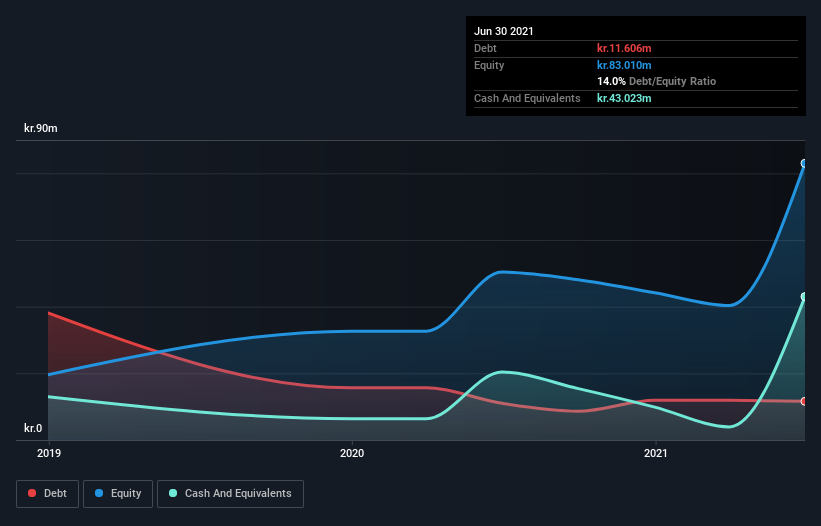- Denmark
- /
- Electrical
- /
- CPSE:LEDIBOND
Health Check: How Prudently Does LED iBond International (CPH:LEDIBOND) Use Debt?

Some say volatility, rather than debt, is the best way to think about risk as an investor, but Warren Buffett famously said that 'Volatility is far from synonymous with risk.' So it seems the smart money knows that debt - which is usually involved in bankruptcies - is a very important factor, when you assess how risky a company is. Importantly, LED iBond International A/S (CPH:LEDIBOND) does carry debt. But the real question is whether this debt is making the company risky.
When Is Debt A Problem?
Generally speaking, debt only becomes a real problem when a company can't easily pay it off, either by raising capital or with its own cash flow. Part and parcel of capitalism is the process of 'creative destruction' where failed businesses are mercilessly liquidated by their bankers. However, a more common (but still painful) scenario is that it has to raise new equity capital at a low price, thus permanently diluting shareholders. Of course, the upside of debt is that it often represents cheap capital, especially when it replaces dilution in a company with the ability to reinvest at high rates of return. The first step when considering a company's debt levels is to consider its cash and debt together.
View our latest analysis for LED iBond International
What Is LED iBond International's Net Debt?
As you can see below, at the end of June 2021, LED iBond International had kr.11.6m of debt, up from kr.11.0m a year ago. Click the image for more detail. However, its balance sheet shows it holds kr.43.0m in cash, so it actually has kr.31.4m net cash.

A Look At LED iBond International's Liabilities
The latest balance sheet data shows that LED iBond International had liabilities of kr.14.4m due within a year, and liabilities of kr.6.87m falling due after that. On the other hand, it had cash of kr.43.0m and kr.7.17m worth of receivables due within a year. So it actually has kr.28.9m more liquid assets than total liabilities.
This excess liquidity suggests that LED iBond International is taking a careful approach to debt. Given it has easily adequate short term liquidity, we don't think it will have any issues with its lenders. Succinctly put, LED iBond International boasts net cash, so it's fair to say it does not have a heavy debt load! There's no doubt that we learn most about debt from the balance sheet. But you can't view debt in total isolation; since LED iBond International will need earnings to service that debt. So if you're keen to discover more about its earnings, it might be worth checking out this graph of its long term earnings trend.
In the last year LED iBond International had a loss before interest and tax, and actually shrunk its revenue by 8.6%, to kr.9.3m. That's not what we would hope to see.
So How Risky Is LED iBond International?
Statistically speaking companies that lose money are riskier than those that make money. And in the last year LED iBond International had an earnings before interest and tax (EBIT) loss, truth be told. And over the same period it saw negative free cash outflow of kr.19m and booked a kr.16m accounting loss. Given it only has net cash of kr.31.4m, the company may need to raise more capital if it doesn't reach break-even soon. Even though its balance sheet seems sufficiently liquid, debt always makes us a little nervous if a company doesn't produce free cash flow regularly. When analysing debt levels, the balance sheet is the obvious place to start. However, not all investment risk resides within the balance sheet - far from it. Case in point: We've spotted 5 warning signs for LED iBond International you should be aware of, and 1 of them is a bit unpleasant.
If you're interested in investing in businesses that can grow profits without the burden of debt, then check out this free list of growing businesses that have net cash on the balance sheet.
New: AI Stock Screener & Alerts
Our new AI Stock Screener scans the market every day to uncover opportunities.
• Dividend Powerhouses (3%+ Yield)
• Undervalued Small Caps with Insider Buying
• High growth Tech and AI Companies
Or build your own from over 50 metrics.
This article by Simply Wall St is general in nature. We provide commentary based on historical data and analyst forecasts only using an unbiased methodology and our articles are not intended to be financial advice. It does not constitute a recommendation to buy or sell any stock, and does not take account of your objectives, or your financial situation. We aim to bring you long-term focused analysis driven by fundamental data. Note that our analysis may not factor in the latest price-sensitive company announcements or qualitative material. Simply Wall St has no position in any stocks mentioned.
Have feedback on this article? Concerned about the content? Get in touch with us directly. Alternatively, email editorial-team (at) simplywallst.com.
About CPSE:LEDIBOND
Slight with imperfect balance sheet.
Market Insights
Community Narratives




